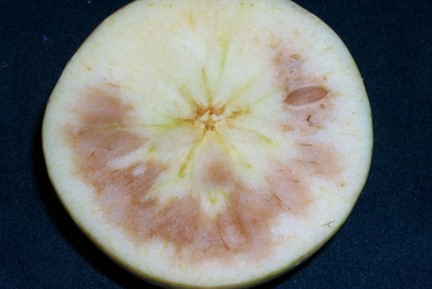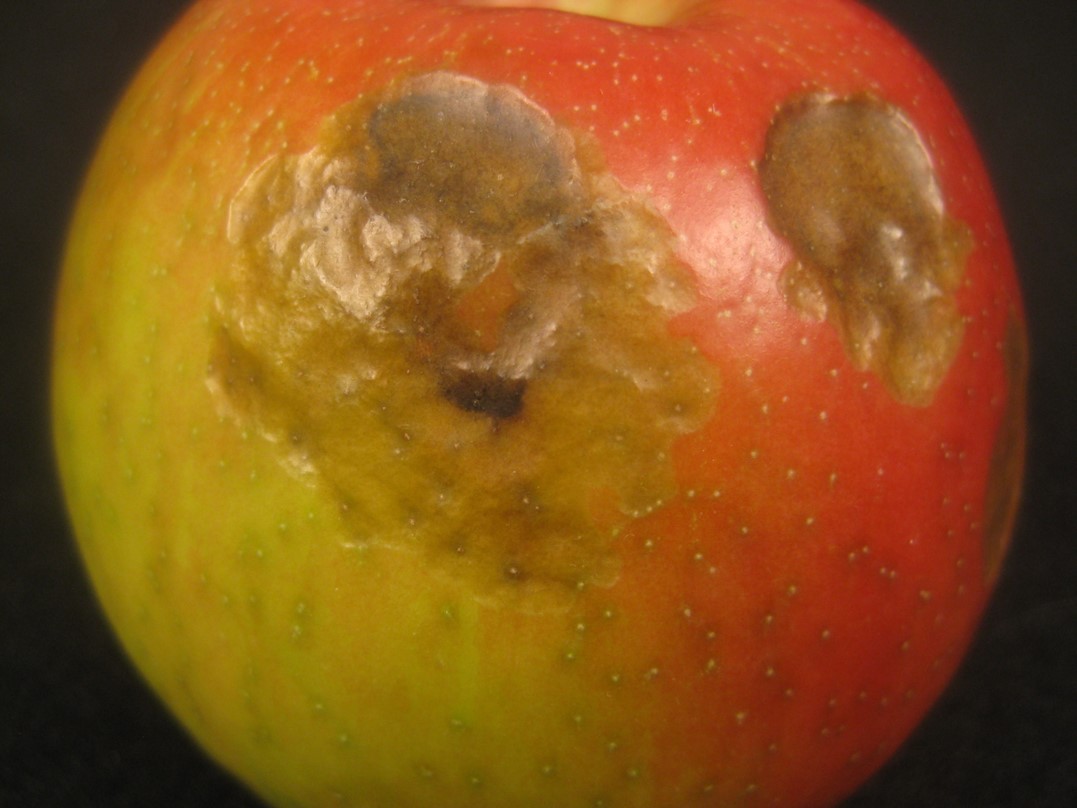Comprehensive Honeycrisp harvest and storage recommendations
Honeycrisp storage options are many and successful storage, especially for long-term, depends on efforts in the field as well as postharvest. Here we discuss those options, focusing on successful storage 'recipes' for Honeycrisp with various options.

Honeycrisp apple fruit are difficult to store due to a number of postharvest issues. One of the most important problems is the extremely high sensitivity to chilling (Fig. 1). Pre-storage conditioning (five to seven days at 50 - 60 Fahrenheit) provides good protection, but the fruit still need to be stored at temperatures a few degrees above freezing. Our recommended storage temperature is 36 - 38 F; lower temperatures may be successful sometimes if the fruit are conditioned, but we have seen problems following storage of pre-conditioned fruit at 32 F. Prestorage conditioning can enhance the development of bitter pit, so our recommendation is to selectively store fruit with low potential for bitter pit development where possible. Honeycrisp are also sensitive to injury by CO2 in storage (Fig. 2). The injury due to CO2 is slightly higher for less mature fruit and it is also dependent upon the O2 level in the storage in such a way that lower O2 levels increase injury. We recommend some form of protection from CO2 injury, and we have previously had very good success for several years with an intense conditioning period of five to seven days at 68 F. A shorter conditioning period (three days) at higher temperatures (75 - 80 F) may be similarly effective. Unfortunately, this form of intensive conditioning can advance ripening and can slightly shorten storability. Treatment with diphenylamine (DPA) as a drench or thermofog is very effective at suppressing CO2 injury in Honeycrisp and would certainly be able to substitute for a preconditioning treatment in terms of controlling CO2 injury. DPA has no meaningful suppressive effect on chilling injury. Another alternative to CA storage is the use of 1-MCP to suppress ripening. Results so far have been quite favorable, but there may be a slight enhancement of sensitivity to CO2 injury. Also, 1-MCP treatment has been known to exacerbate a disorder known as leather blotch (Fig. 3), which is orchard-specific, and little is known about causes of this injury. We strongly recommend monitoring CO2 levels during room loading and the initial cooling period, venting the room if necessary. That being said, high O2 levels (e.g., air with 21% O2) suppress CO2 injury. The following are our recipes for storage of Honeycrisp with some estimates of storability. These recommendations are drawn from work by MSU, Cornell, Washington State, and Ontario researchers. More information on the harvest and maturity of Honeycrisp and other apple fruit can be found at MSU Extension.


Pre-storage
Color management
Honeycrisp, like most, if not all apple cultivars, typically store better if they are harvested early in the maturation, rather than later. To harvest Honeycrisp on the early side, use available tools (reflective ground covers, pruning for maximizing light penetration, use early coloring cultivars, avoid early ripening cultivars).
Bitter pit management
Manage crop load and minimize biennial bearing to even out production and reduce the risk of bitter pit. Provide adequate calcium using five to eight sprays beginning shortly after fruit set. Avoid bitter pit promoting rootstocks and orchard sites. Use historical records to identify risky sites and avoid them for long-term storage.
Harvest management
Use of early coloring cultivars (not early ripening cultivars like Premier and others) and growth regulators is encouraged. Use lower rates of ReTain (repeated applications can be OK) or Harvista - with or without NAA to control fruit drop. Better color might be obtained from Harvista-treated blocks since the inhibitory treatment is later in development and can interfere with red coloration less than ReTain.
Air storage
Air storage (no 1-MCP)
- Harvest at optimal maturity - prior to 60% starch clearing (Starch Index less than 6 on Cornell Starch Chart) and ground color change from green to yellow.
- Precondition for five to seven days at 50 F to suppress chilling injury (make sure CO2 levels do not exceed 1% - this is especially important for fruit from young trees).
- Store at 36 - 38 F for three to four months, slightly longer if initial maturity was less.
Air storage (with 1-MCP)
- Harvest at optimal maturity - prior to 60% starch clearing (Starch Index less than 6 on Cornell Starch Chart) and ground color change from green to yellow.
- Treat with 1-MCP (1 ppm, 24 hr) during preconditioning if possible. Repeat applications of 1-MCP are not helpful if the interval is 1.5 months of greater.
- Precondition for five to seven days at 50 F to suppress chilling injury (make sure CO2 levels do not exceed 1% - this is especially important for fruit from young trees).
- Store at 36 - 38 F for up to five months, slightly longer if initial maturity was less.
CA Storage
CA storage (no DPA, no 1-MCP)
OPTION 1 (mild preconditioning)
- Harvest at optimal maturity - prior to 60% starch clearing (Starch Index less than 6 on Cornell Starch Chart) and ground color change from green to yellow.
- Precondition for five to seven days at 50 F to suppress chilling injury (make sure CO2 levels do not exceed 1% - this is especially important for fruit from young trees).
- Store at 36 - 38 F for at least a month with CO2 levels ~ 0.5 to 1% and O2 between 1.5 and 3%. Then:
- Standard CA: Store at 36 - 38 F for an additional ~ five to six months (~ six to seven months total) with CO2 level 3% and O2 between 1.5 and 3%. Fruit can be held longer if initial maturity was less.
- Low O2 CA: Store at 36 – 38 F for ~six to seven months (~ seven to eight months total) with CO2 level of 1% and O2 level of 0.5 to 1% (use DCA technology if available). Fruit can be held longer if initial maturity was less.
OPTION 2 (intense preconditioning to help control CO2 injury)
- Harvest at optimal maturity - prior to 60% starch clearing (Starch Index less than 6 on Cornell Starch Chart) and ground color change from green to yellow.
- Precondition for three to five days at 70 F to suppress chilling and CA injuries (make sure CO2 levels do not exceed 1% - this is especially important for fruit from young trees). Intense preconditioning will shorten storability somewhat and can enhance bitter pit development. Then:
- Standard CA: Store at 36 - 38 F for ~ six months with CO2 level of <1% and O2 between 1.5 and 3%. Fruit can be held longer if initial maturity was less.
- Low O2 CA: Store at 36 – 38 F for ~ six to seven months with CO2 level of 1% and O2 level of 0.5 to 1% (use DCA technology if available). Fruit can be held longer if initial maturity was less.
CA storage (no DPA, with 1-MCP)
OPTION 1 (mild preconditioning)
- Harvest at optimal maturity - prior to 60% starch clearing (Starch Index less than 6 on Cornell Starch Chart) and ground color change from green to yellow.
- Treat with 1-MCP (1 ppm, 24 hr - at same time as preconditioning).
- Precondition for five to seven days at 50 F to suppress chilling injury (make sure CO2 levels do not exceed 1% - this is especially important for fruit from young trees).
- Store at 36 - 38 F for up to a month with CO2 levels below 1% and O2 between 1.5 and 3%. Then:
- Standard CA: Store at 36 - 38 F for ~ six to seven months (~ seven to eight months total) with CO2 level less than 1%% and O2 between 1.5 and 3%. Fruit can be held longer if initial maturity was less.
- Low O2 CA: Store at 36 - 38 F for ~ seven to eight months (~ eight to nine months total) with CO2 level of less than 1% and O2 level of 0.5 to 1% (use DCA technology if available). Fruit can be held longer if initial maturity was less.
OPTION 2 (intense preconditioning)
- Harvest at optimal maturity - prior to 60% starch clearing (Starch Index less than 6 on Cornell Starch Chart) and ground color change from green to yellow.
- Treat with 1-MCP (1 ppm, 24 hr - at same time as preconditioning).
- Condition for three to five days at 70 F to suppress chilling and CA injuries (make sure CO2 levels do not exceed 1% - this is especially important for fruit from young trees). Intense preconditioning will shorten storability somewhat and can enhance bitter pit development. Then:
- Standard CA: Store at 36 - 38 F for ~ six to seven months with CO2 level less than 1%% and O2 between 1.5 and 3%. Fruit can be held longer if initial maturity was less.
- Low O2 CA: Store at 36 - 38 F for ~ seven to eight months with CO2 level of <1% and O2 level of 0.5 to 1% (use DCA technology if available). Fruit can be held longer if initial maturity was less.
CA storage (with DPA, no 1-MCP)
- Harvest at optimal maturity - prior to 60% starch clearing (Starch Index less than 6 on Cornell Starch Chart) and ground color change from green to yellow.
- Precondition for five to seven days at 50 F to suppress chilling injury (make sure CO2 levels do not exceed 1% - this is especially important for fruit from young trees). Then:
- Standard CA: Store at 36 - 38 F for ~ six to seven months with CO2 level less than 1% and O2 between 1.5 and 3%. Fruit can be held longer if initial maturity was less.
- Low O2 CA: Store at 36 - 38 F for ~ seven to eight months with CO2 level of ~1% and O2 level of 0.5 to 1% (use DCA technology if available). Fruit can be held longer if initial maturity was less.
CA storage (with DPA, with 1-MCP)
- Harvest at optimal maturity - prior to 60% starch clearing (Starch Index less than 6 on Cornell Starch Chart) and ground color change from green to yellow.
- Treat with 1-MCP (1 ppm, 24 hr - at same time as preconditioning).
- Precondition for five to seven days at 50 F to suppress chilling injury (make sure CO2 levels do not exceed 1% - this is especially important for fruit from young trees).
- Standard CA: Store at 36 - 38 F for ~ eight months with CO2 level of 3% and O2 between 1.5 and 3%. Fruit can be held longer if initial maturity was less.
- Low O2 CA: Store at 36 - 38F for ~ nine to ten months with CO2 level of ~1% and O2 level of 0.5 to 1% (use DCA technology if available). Fruit can be held longer if initial maturity was less.



 Print
Print Email
Email